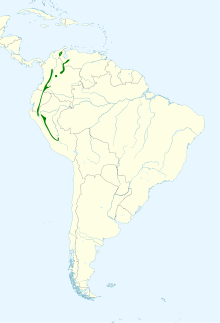| Subtropical cacique | |
|---|---|

| |
| in Colombia | |
| song | |
| Conservation status | |
 Least Concern (IUCN 3.1) | |
| Scientific classification | |
| Domain: | Eukaryota |
| Kingdom: | Animalia |
| Phylum: | Chordata |
| Class: | Aves |
| Order: | Passeriformes |
| Family: | Icteridae |
| Genus: | Cacicus |
| Species: | C. uropygialis |
| Binomial name | |
| Cacicus uropygialis Lafresnaye, 1843 | |

| |
The subtropical cacique (Cacicus uropygialis) is a passerine bird species in the New World family Icteridae. It breeds in the lower reaches of the northern Andes.
Description
The subtropical cacique is sexually dimorphic like many Icteridae, though it mainly concerns size in this species. Males are 25 cm (10 in) (being slightly larger than their fellow scarlet-rumped caciques, they follow Bergmann's Rule). This cacique is a slim long-winged bird, with a relatively short tail, blue eyes, and a pale yellow pointed bill. It has mainly black plumage, apart from a scarlet patch on the lower back and upper rump. The female is smaller and a duller black than the male, and the juvenile bird has a brownish tone to the plumage and a brownish-orange rump.
The song calls of the subtropical cacique sound rather atypical for icterids and more like the chatter of an excited great thrush (Turdus fuscater).
Ecology and distribution

Subtropical caciques have been recorded as high as 2,450 m (8,040 ft) ASL and are found along Andean slopes at altitudes of 1,000–2,300 m (3,300–7,500 ft) in submontane or cloud forest, ranging from Venezuela, through Colombia and Ecuador, to Peru, with an isolated population in the Serranía del Perijá. Their habitat has a lower canopy than scarlet-rumped caciques, dominated by trees of little more than 15–20 m (49–66 ft) high ; oaks (Quercus) but also Epiphytes, hemiepiphytes like Coussapoa (Urticaceae), and a usually dense understory with tree ferns, Ericaceae, etc. are all typical habitat features.
These caciques forage through the canopy in small flocks. It feeds on large insects, spiders and small vertebrates, but will also take some fruit. It often forms mixed-species feeding flocks with similarly robust and rowdy songbirds, such as other icterids, black-faced grosbeaks (Caryothraustes poliogaster), or American jays. Such noisy flocks may also attract trogons or flycatchers.
Unlike some other caciques they are not usually colonial breeders; like them they have a bag-shaped nest. It is built about 3.5–30 m (11–98 ft) above ground, in a tree which usually also contains an active wasp nest. The bird's nest is 36–64 cm (14–25 in) long, widens at the base, and is suspended from the end of a branch. The normal clutch is two dark-blotched white eggs. The male will assist in feeding the young, but does not incubate.
The subtropical cacique is generally uncommon to rare, but due to its extensive range unlikely to be seriously threatened.
Footnotes
- BirdLife International (2020). "Cacicus uropygialis". IUCN Red List of Threatened Species. 2020: e.T22733589A138356612. doi:10.2305/IUCN.UK.2020-3.RLTS.T22733589A138356612.en.
- ^ Salaman et al. (2002)
- E.g. mountain cacique (Cacicus leucoramphus) or russet-backed oropendola (Psarocolius angustifrons), observed for subtropical caciques: Salaman et al. (2002).
- E.g. green jay (Cyanocorax yncas) or white-collared jay (Cyanolyca viridicyana), observed for neotropical caciques: Salaman et al. (2002).
References
- Jaramillo, Alvaro & Burke, Peter (1999): New World Blackbirds. Christopher Helm, London. ISBN 0-7136-4333-1
- Salaman, Paul G.W.; Stiles, F. Gary; Bohórquez, Clara Isabel; Álvarez-R., Mauricio; Umaña, Ana María; Donegan, Thomas M. & Cuervo, Andrés M. (2002): New and noteworthy bird records from the east slope of the Andes of Colombia. Caldasia 24(1): 157–189. PDF fulltext
- South American Classification Committee (SACC) (2003): Proposal #73 – Split Cacicus microrhynchus from C. uropygialis.
- Stiles, F. Gary & Skutch, Alexander Frank (1989): A guide to the birds of Costa Rica. Comistock, Ithaca. ISBN 0-8014-9600-4